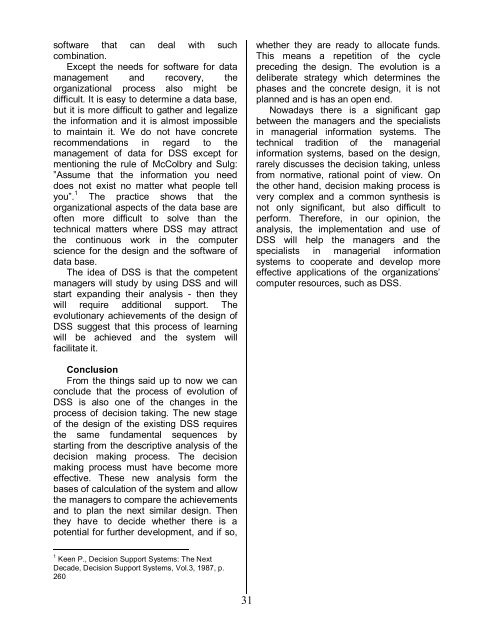ÐÑой 4/2010 - СÑопанÑки ÑакÑлÑÐµÑ - Югозападен ÑнивеÑÑиÑеÑ
ÐÑой 4/2010 - СÑопанÑки ÑакÑлÑÐµÑ - Югозападен ÑнивеÑÑиÑеÑ
ÐÑой 4/2010 - СÑопанÑки ÑакÑлÑÐµÑ - Югозападен ÑнивеÑÑиÑеÑ
You also want an ePaper? Increase the reach of your titles
YUMPU automatically turns print PDFs into web optimized ePapers that Google loves.
software that can deal with such<br />
combination.<br />
Except the needs for software for data<br />
management and recovery, the<br />
organizational process also might be<br />
difficult. It is easy to determine a data base,<br />
but it is more difficult to gather and legalize<br />
the information and it is almost impossible<br />
to maintain it. We do not have concrete<br />
recommendations in regard to the<br />
management of data for DSS except for<br />
mentioning the rule of McColbry and Sulg:<br />
”Assume that the information you need<br />
does not exist no matter what people tell<br />
you”. 1 The practice shows that the<br />
organizational aspects of the data base are<br />
often more difficult to solve than the<br />
technical matters where DSS may attract<br />
the continuous work in the computer<br />
science for the design and the software of<br />
data base.<br />
The idea of DSS is that the competent<br />
managers will study by using DSS and will<br />
start expanding their analysis - then they<br />
will require additional support. The<br />
evolutionary achievements of the design of<br />
DSS suggest that this process of learning<br />
will be achieved and the system will<br />
facilitate it.<br />
whether they are ready to allocate funds.<br />
This means a repetition of the cycle<br />
preceding the design. The evolution is a<br />
deliberate strategy which determines the<br />
phases and the concrete design, it is not<br />
planned and is has an open end.<br />
Nowadays there is a significant gap<br />
between the managers and the specialists<br />
in managerial information systems. The<br />
technical tradition of the managerial<br />
information systems, based on the design,<br />
rarely discusses the decision taking, unless<br />
from normative, rational point of view. On<br />
the other hand, decision making process is<br />
very complex and a common synthesis is<br />
not only significant, but also difficult to<br />
perform. Therefore, in our opinion, the<br />
analysis, the implementation and use of<br />
DSS will help the managers and the<br />
specialists in managerial information<br />
systems to cooperate and develop more<br />
effective applications of the organizations’<br />
computer resources, such as DSS.<br />
Conclusion<br />
From the things said up to now we can<br />
conclude that the process of evolution of<br />
DSS is also one of the changes in the<br />
process of decision taking. The new stage<br />
of the design of the existing DSS requires<br />
the same fundamental sequences by<br />
starting from the descriptive analysis of the<br />
decision making process. The decision<br />
making process must have become more<br />
effective. These new analysis form the<br />
bases of calculation of the system and allow<br />
the managers to compare the achievements<br />
and to plan the next similar design. Then<br />
they have to decide whether there is a<br />
potential for further development, and if so,<br />
1<br />
Keen P., Decision Support Systems: The Next<br />
Decade, Decision Support Systems, Vol.3, 1987, p.<br />
260<br />
31
















